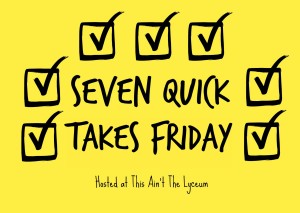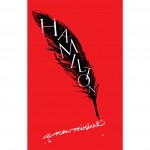Two housekeeping notes: you can still vote for me in the “Smartest Blog” category in the Sheenazing Awards, and my weekly radio show will be streaming tomorrow at 5pm and again on Sunday at 1pm,
Folks, this archery video (found via Deadspin) has made my day. Based on nerdy examination of historical art of archers, Lars Anderson overhauled his shooting technique and, well, let me let Deadspin summarize, since I prefer only to swear in direct quotations:
What if I told you that the motherfucker jumps into the air, catches an arrow that was fired at him by another archer, and then fires that arrow back before he hits the ground? At one point, he spins around and fires an arrow straight through another arrow that had just been fired at his back. Watch the video!
Lo, here it is:
And speaking of swearing, the Economist had an interesting piece on cussin’ in Quebec, where the legacy of Catholicism has shaped what the folks there consider linguistically beyond the pale:
Church attendance has plummeted over the past few decades in Quebec, but a distinctive clutch of swear-words in the local variety of French are still some of the roughest words in the language: chalice (calisse!) and “host” (hosti), for example.
I’ve been tempted to use some intemperate language to describe my frustration with Peter Jackson’s adaptation of The Hobbit (I saw the first one, and then couldn’t bring myself to see any more), but I’m encouraged by this fan edit that recuts all three movies into a single four-hour film. Especially when I see the logic that informed his edits:
Several of the orc skirmishes have been cut. I felt that the Battle of the Five Armies provided more than enough orc mayhem. If you pack in too much before then, they just become monotonous, and it lessons their menace in the audience’s mind. I was tempted to leave in the very first Azog confrontation (since it resembles a chapter from the novel), but decided to cut it for a variety of reasons. Specifically, I found it tonally jarring to jump from the emotional crescendo of Thorin being saved by Bilbo (and the sense of safety the company feels after being rescued by the eagles), straight back into another chase sequence. Plus, I think the film works better if Bilbo is still trying to earn Thorin’s respect the entire journey, as he was in the novel. Not to mention the absurdity of Bilbo suddenly turning into John McClane with a sword!
Darn tootin! Bilbo’s McClane moments undermine the whole arc of his relationship with Thorin (as I previously complained in “Peeta Already Kicks Ass, No Blood Needed”):
Peter Jackson kept giving Bilbo “Took a Level in Badass” moments that were not in the books (e.g. when he faced off a warg to defend Thorin). Instead of the dwarfs learning that courage comes in many forms, and growing to respect their little thief, Jackson had Bilbo become a warrior, so that Thorin only came to respect Bilbo when he resembled himself.
While we’re discussing character arcs, I really enjoyed this longreads essay by FILM CRITIC HULK on movies where the main character remains pretty much the same, and it’s the audience who goes through an arc, as their relationship with the protagonist changes.
There is a sub-genre of what Hulk likes to call “event movies” – wherein some big event or moment is characterized through a dramatic retelling (Though it’s not really a genre. More of a story tactic). The most obvious and stalwart example of these kinds of films is in the work of Paul Greengrass. Bloody Sunday. United 93. Captain Phillips. It is pretty well agreed upon that all these films are both remarkable and affecting. And Hulk should note that Hulk tends to love good event movies because they get at something Hulk will illustrate in just a second, but Hulk also worries that a lot of people don’t seem to understand how they work (even when they like them). To wit, one of the most common justifications in the praise of these films is how they are “docu-like” and therefore are able to get to the “reality” of the event… Sorry, but that’s just sensing the mere texture and aesthetic of the movie (the tangible detail). And yeah those are cognitive cues that sure help immerse us and all, but on a pure story level, making something “docu-like” does absolutely nothing. No, what makes a good event film on a story level is often two-fold: 1) treating the event itself as the main character, wherein the developments of the event (or what is planned) unfold with a solid cause-and-effect model of good plotting. And 2) that as many scenes as possible highlight a strong ideological conflict at the heart of the event, so that the nature of ideology will get thrown into sharp relief, often through the characters’ ongoing conflict with each other. That sounds complicated, but for a perfect recent example look to Selma, which is rightfully earning raves (Hulk just saw it a second ago and can’t believe how well it fits in this discussion). The film touches on many characters and stories and while they may be going up and down with changes and doubts, would you necessarily say that any of them have strong arcs? Not really, no. Instead, the story arc belongs to the event and the people who make up the town of Selma (wonder why they named the movie that, huh?). And it is telling the story of how protesting works, from idea to implementation to effect. And it explores that through the dramatic interaction of the key persons involved, all to highlight the larger ideological issues. The event itself is the main character, as human and nuanced as any great character must be. Hulk swears to you, without those two bits of key understanding mentioned above, you’re just going to end up telling a boring story in shaky-cam.
(for folks who don’t like reading ALL CAPS TEXT, zap the essay into Convert Case — I did for the blockquoted excerpt)
And while we’re talking about unexpected protagonists and arcs, I found this explanation of the song “Closing Time” which is apparently not mostly about leaving a bar, to be really charming. Plus I’ve liked the song since it was played at summer camp dances.
Ok, and now to pick another example of songs that are unexpectedly about exits from aqueous environments… The American Museum of Natural History had a very charming story about the discovery of the coelacanth. Well, kind of the re-discovery, in that scientists knew about the fish as a fossil and were surprised to find it still existed. (The fish is huge, by the way. How huge you ask? Well…)
Elbows-deep in fish innards, Smith and Rand found three embryonic coelacanths—1-foot-long versions of their mother, with yolk sacs still attached. (emphasis mine)
Anyway, about that song:
The hematologist, Dr. Rand, was so inspired by the ichthyological revelation that he penned a libretto for a short operetta, A Coelacanth’s Lament, or Quintuplets At 50 Fathoms Can Be Fun, set to Gilbert and Sullivan tunes. Here’s a selection from Act One, to be sung to the melody of The Mikado’s “Tit Willow:”
The Coelacanth sat and unburdened her heart sighing, “fossil, oh fossil, I’m a fossil!” “It’s evident that ‘neath my two-chambered heart there’s no fossil, no fossil, no fossil. “Yes the bulge that you see there expanding my girth “Is nothing to laugh at, it aint got no mirth. “And I probablt will have a quintuplet birth, fossil, oh fossil, I’m a fossil!”
That last is hard to top, I know, but I can do it. I’ve just discovered this week that there’s a new Tom Stoppard play debuting in England… and that it will be broadcast to US theaters through NTLive! Eeeeeeee! Meanwhile, last night I hosted a read-aloud party of Stoppard’s Arcadia, and visited five DC libraries in the course of amassing scripts, as you can see below. We had a wonderful time. 
For more Quick Takes, visit Conversion Diary!













